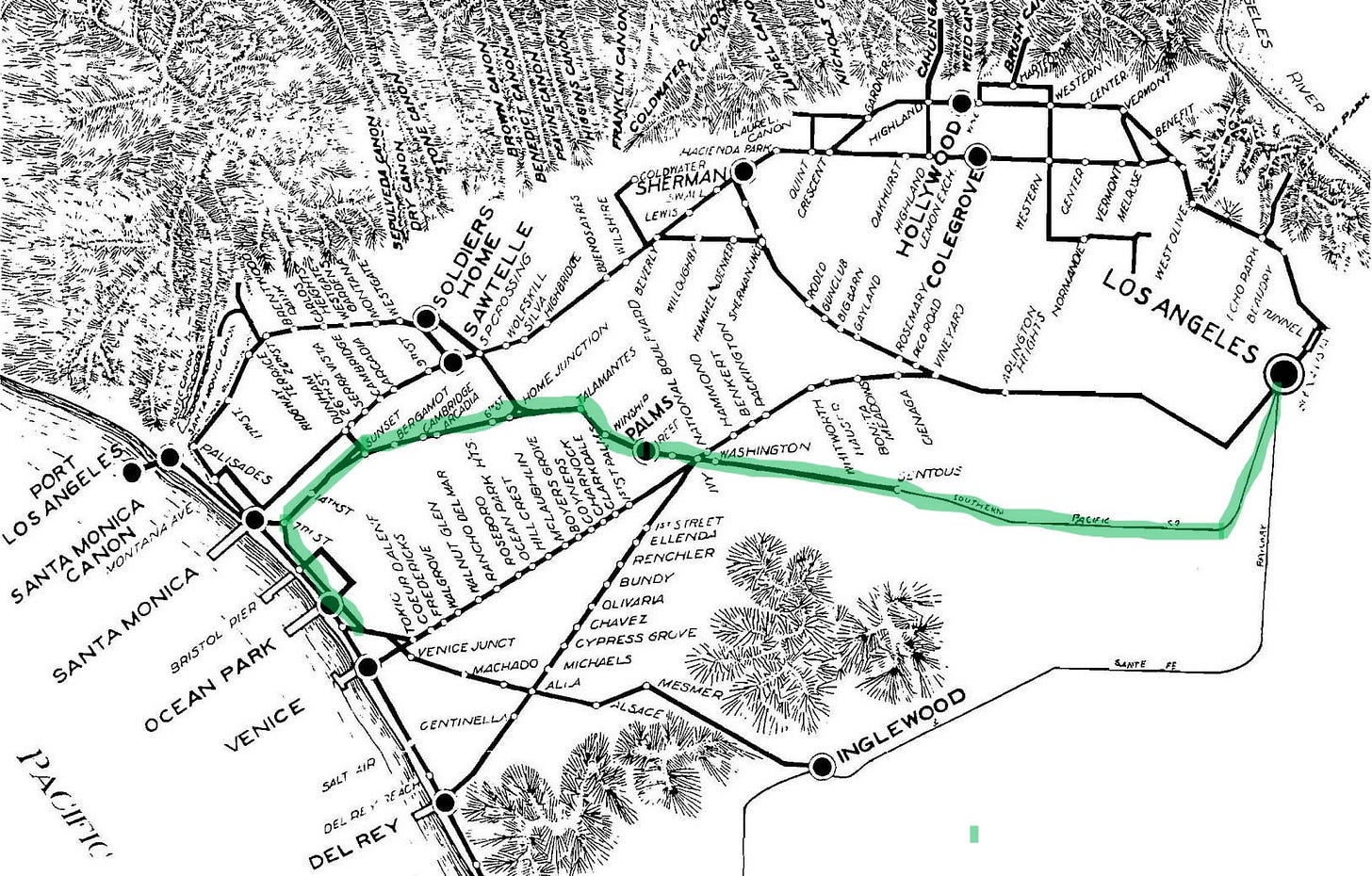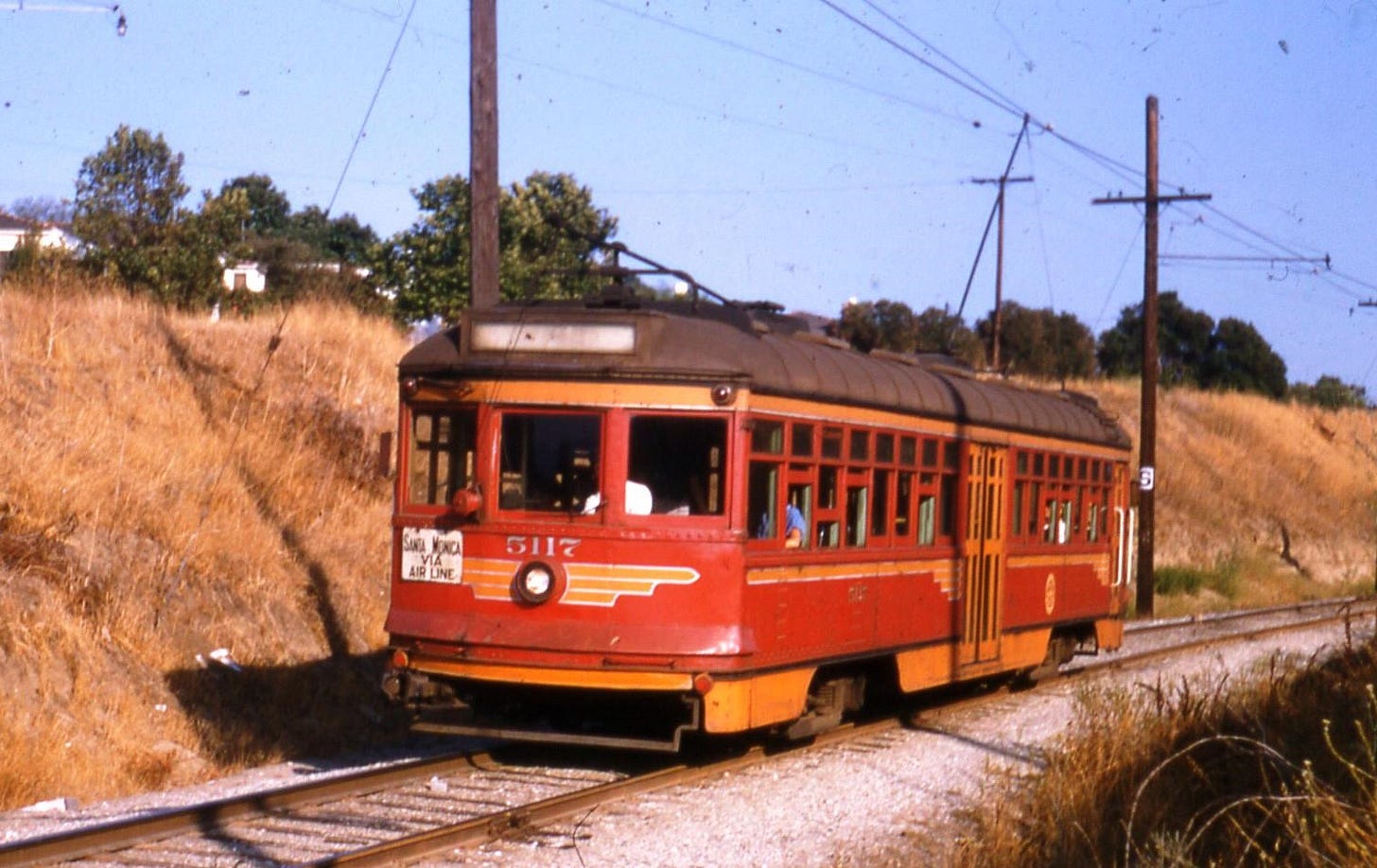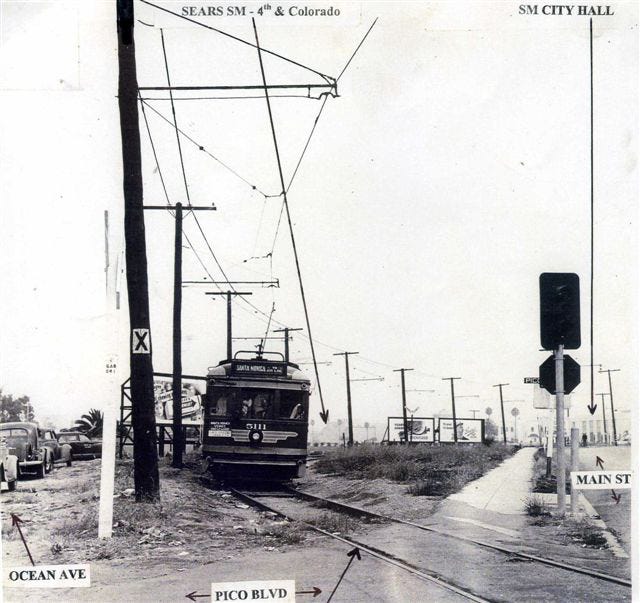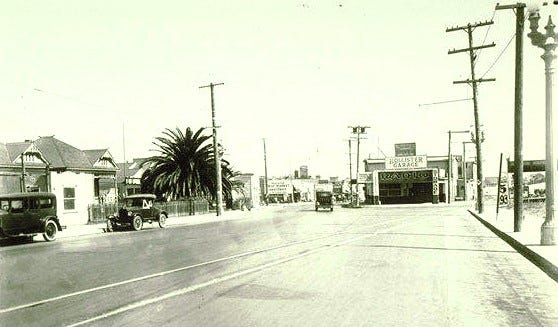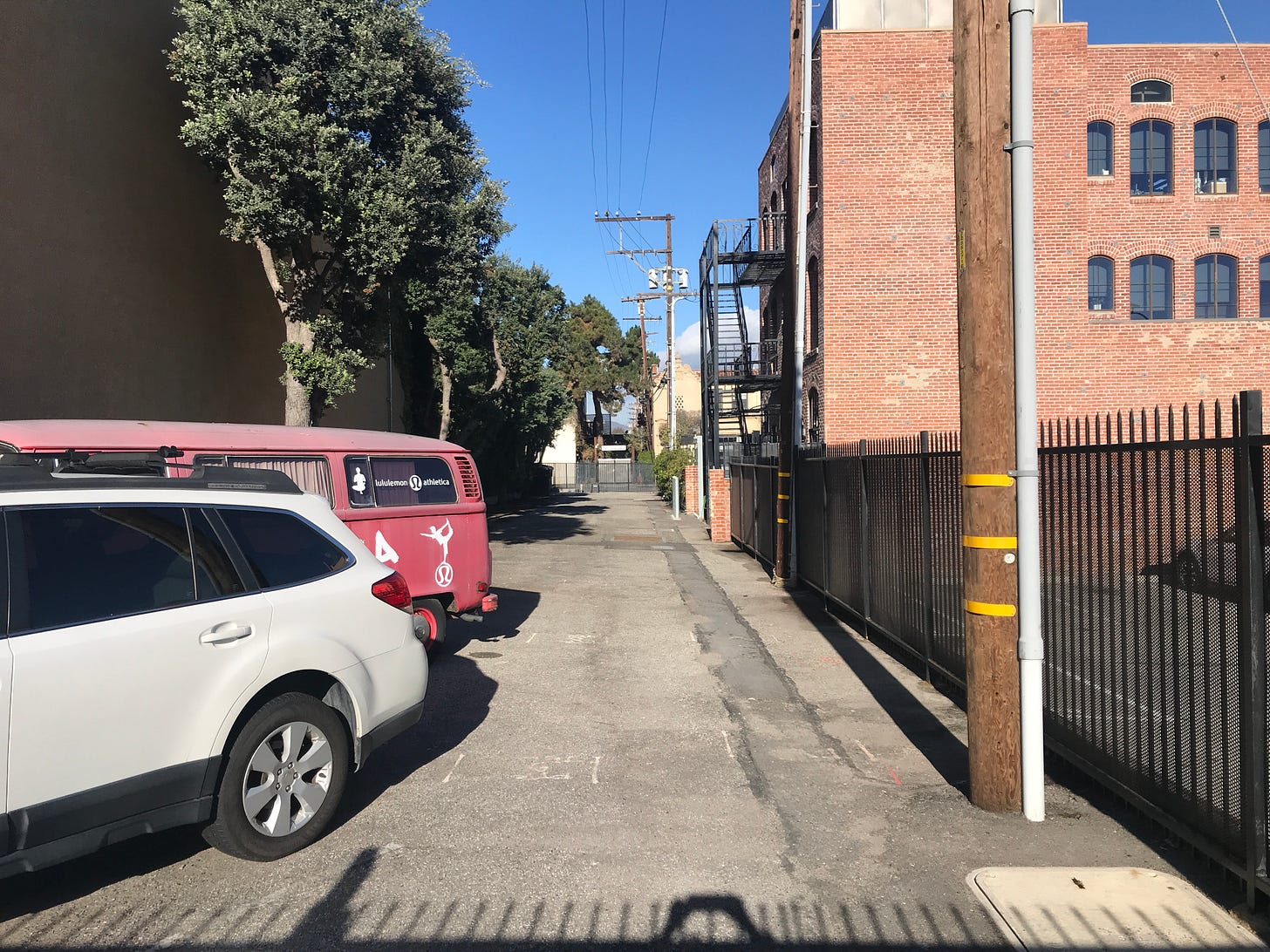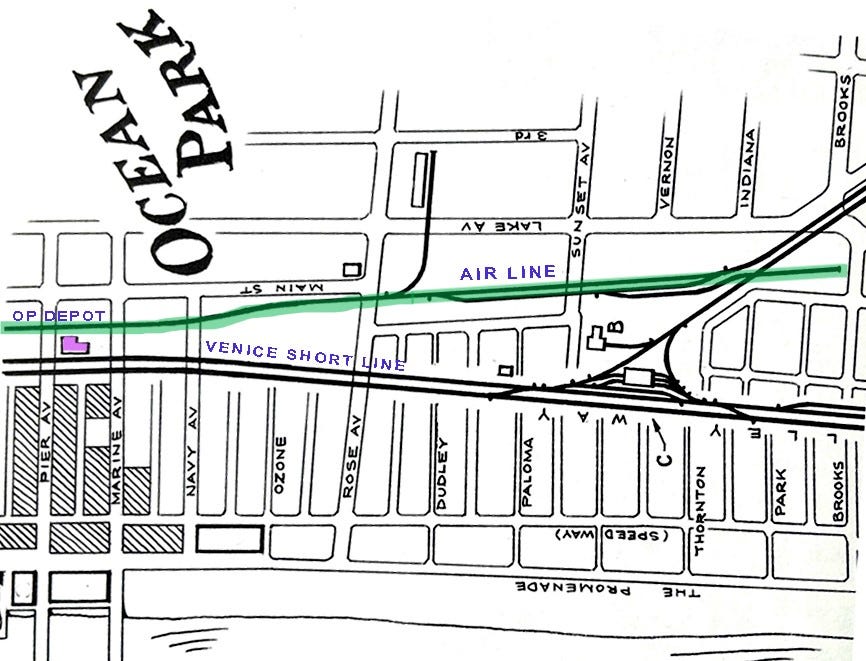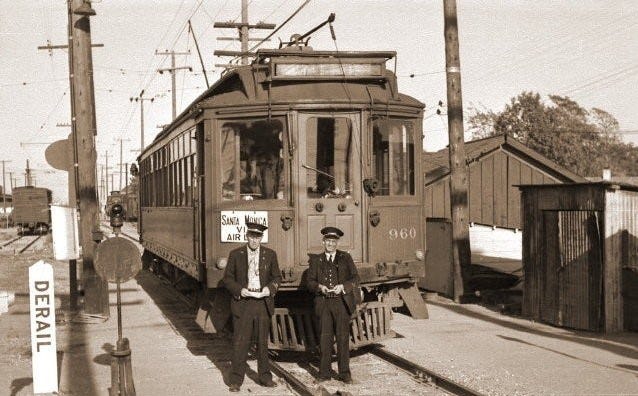Santa Monica Air Line is a Pacific Electric streetcar service that from 1909 to 1953, runs from downtown Los Angeles to Santa Monica (and Ocean Park).
In 1875, the Los Angeles and Independence Railroad (LA & I) builds a steam train freight line linking a proposed Santa Monica seaport (Port Los Angeles) to downtown Los Angeles. LA & I passes through a succession of owners,1 eventually becoming part of the Los Angeles Pacific (LAP) and then Pacific Electric in 1911.
In 1908, Los Angeles Pacific (LAP) replaces the steam trains with electric trolleys. With its roots as a single-track, freight railway for big steam engines running for the most part on a dedicated right-of-way, the trolley line is unusual as most Los Angeles's trolley routes share crowded roadways with automobiles and pedestrians. Fewer station stops and street crossings make for a quicker, almost express, trip between downtown Los Angeles and Santa Monica. Because it is a direct line, traveling almost as a bird flies, Pacific Electric names the route Santa Monica Air Line.
The line enters Santa Monica paralleling Exhibition Blvd, and makes several stops in Santa Monica2 before heading south into Ocean Park.3
From 5th St and Colorado, the line curves southeast to meet Pico near Ocean Ave, just west of Main Street.
From Pico, the trolleys travel south along the center of Main St to Hollister.
At Hollister, the trolleys turn slightly west and enter the old Santa Fe right-of-way track directly behind (west) Main St.
Then along the Santa Fe right-of-way behind Main St (without stopping in Ocean Park) to the terminus at the Ocean Park Car House at Main St and Sunset Ave / Thornton Pl in Venice.4
Santa Monica Air Line passenger service tends to be an annoyance to Pacific Electric.5 Built as a freight line, the route, much of which is sparsely populated, while faster, is also an obstacle to its own success. Competing lines travel through busy sections of the city - places where people actually want to get on and off.
Initially, Santa Monica Air Line operated every hour. By 1924, the service is reduced to passenger cars running only during rush hours. By 1931, only a single daily round-trip operates on the line. In 1932, Pacific Electric files with the Railroad Commission to discontinue the service entirely. Dedicated patrons of the line6 successfully block attempts to close the line.7 Santa Monica Air Line limps along for a few more decades until it is finally abandoned in 1953.8
After Santa Monica Air Line passenger service is abandoned, the trolley electric wire is removed, and diesel locomotives take over all freight movements. By the 1970s, the western end of the line is at Fisher Lumber, from where the final freight run is made in 1988.
In 1990, LA Metro purchases Santa Monica Air Line from Southern Pacific for future public transit use. Various construction tasks and rack replacement begin in 2006, and the first phase of the Expo Line from downtown Los Angeles to Culver City opens in 2012. Service for the second phase to Santa Monica begins in 2016.
Just two years after the line opens, the LA & I is sold to the Southern Pacific Railroad. Southern Pacific, hoping to build a freight business, builds the Long Wharf at Santa Monica in hopes of beating out Long Beach and San Pedro as a major shipping port. When that does not work out, Southern Pacific leases the line to the Los Angeles Pacific (LAP) in 1908. All of the LAP holdings and infrastructure are taken over by Pacific Electric Railroad in the Great Merger of 1911.
The original 1875 Los Angeles & Independence track is a 3' 6” narrow-gauge steam line. Southern Pacific converts it to 4' 8.5"standard gauge, and electric operations start in 1908.
From Los Angeles, the first stop in Santa Monica is at the Santa Monica Air Line Bergamot Station located at Centinela Ave. The next stop is Sunset Station is a large rail yard located at Cloverfield (the current Expo Line Bergamot station). The next stop is Santa Monica Station, located at 14th St. - near Fisher Lumber. The next stop is Tool House at 5th St (the current terminus of the Expo Line at the former Sears Auto lot).
In an effort to attract a ridership, Pacific Electric is continuously making changes in the schedule and stops. In the early years, Santa Monica Air Line terminates at the Santa Monica Depot at Ocean and Broadway. After 1940, the line terminates at the Ocean Park Car House, where the street cars are stored overnight.
Actually the line doesn't really end at the Ocean Park Car House, but continues to Venice, Marina Del Rey, Westchester, and Inglewood, on a private right-of-way. This part of the line, named the Inglewood Line, is abandoned in late 1928.
As part of its franchise agreement, Pacific Electric is required by the Railroad Commission (now the California Public Utilities Commission) to continue to operate the line.
The Pacific Electric Venice Short Line, which provides much more frequent service to essentially the same west Los Angeles destinations, is abandoned in 1950.
When Pacific Electric is sold to the Metropolitan Coach Lines in 1953, Santa Monica Air Line is not included in the sale - the right-of-way is unsuited to buses. So for about 30 days in October 1953, Santa Monica Air Line is the last passenger service of the Pacific Electric.




